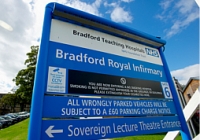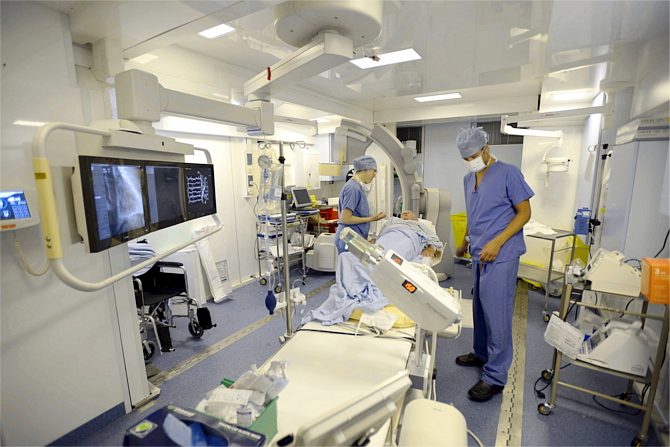Bradford Teaching Hospitals Completes Large UK Image Migration Project
Thanks to Agfa, BridgeHead, Dell
This is a Press Release edited by StorageNewsletter.com on April 3, 2015 at 3:05 pmBradford Teaching Hospitals NHS Foundation Trust (Bradford) has completed one of the UK’s largest image migration projects thanks to a four-way partnership alongside healthcare data management specialists, BridgeHead Software Ltd, Dell, Inc. and Agfa-Gevaert N.V.
A total of 1.7 million radiology studies, equating to 126 million DICOM images and 27TB of data, have been transferred from the central data store (as provided under the National PACS contracts) at a rate of up to 1.4 million images per day into BridgeHead’s Vendor Neutral Archive (VNA), HealthStore.
HealthStore enables the Trust to take complete ownership of, in this case, its radiology image data, stored and protected, all without being tied to an application or hardware technology. It supports the Trust’s aspirations for a hospital-wide enterprise archive for all medical and non-medical images and other clinical and non-clinical data – where this information can be accessed by clinicians at the point of care. All images and other associated data types are safeguarded as they are ingested providing protection and availability. And, by having all data managed from a single location, it is easier to share with clinicians, and other authorised personnel, when they need it.
Planning for National PACS exit
In late 2013, Bradford commenced a project to determine how it would best exit from the National Picture Archiving and Communication System [PACS] Programme, for which the contract was ending in June 2014. As one of the first steps in the project, the Trust made a strategic investment in its storage infrastructure selecting Dell Compellent as the enterprise-wide environment.
In February 2014, the Trust invested in BridgeHead’s VNA to create a technology agnostic and standards-based radiology image store. The VNA is spread across two data centres and all data is mirrored; the Trust has two live copies and a backup, so they have three working copies of the data at any one time. In essence, this avoids replicating data errors; independent copies are taken from the data source, so if one copy is corrupted on write, the others will not be affected.
Ian White, project manager, Bradford, and with previous National PACS Programme exit experience, comments: “Some of the biggest risks for any migration project is ensuring all studies held in the central data store are repatriated within a managed time-frame; and that those images are migrated and transformed into a standard, non-proprietary industry format, thereby ensuring no vendor lock-in at an application level and reducing the risk, management overhead and cost of potential future application changes.“
The Trust worked collaboratively with the incumbent PACS provider to propose, design and develop a solution based on the Image Object Change Management specification (IOCM). IOCM ensures data residing in the PACS database is in sync with the data in the VNA. Should any changes be made to the data in the PACS, these will filter down into the archived data held in the VNA.
White points out: “We went through a comprehensive and rigorous user acceptance programme involving HSCIC to make sure they were comfortable with the proposed solution before we started recalling data from the central data store and transforming it into its native, standards-based format (DICOM) – thereby ensuring the data can be accessed by any DICOM reading system such as other PACS, viewers, etc. – and then into the VNA.“
Data migration from the central data store commenced at the end of August 2014 and was completed by mid-December 2014. Over this time, the VNA was also ingesting new data directly from the PACS application – with minimal impact on users.
The future – a VNA for all imaging disciplines and beyond
Bradford is also looking at the VNA from a multi-disciplinary standpoint and as the Trust’s single, enterprise-wide archive for all clinical imaging and non-image data. This would result in the VNA environment being open to receiving data from other disciplines outside of radiology, such as cardiology for example.
Dr Jonathan Barber, divisional clinical director of clinical support services, comments: “The migration of data from the central data store to an in-house vendor neutral archive has facilitated our exit from the National PACS contract, with the benefit of providing us with a much more resilient local solution. This investment will allow us to plan and realise the second stage of our PACS replacement, which is to provide an updated and integrated, long-term imaging archive, manipulation and display solution. For the first time, this will allow us to archive, manipulate and share images from other clinical modalities outside Radiology, in such specialties as Cardiology, Ophthalmology and Medical Illustration. I consider this ability as key to the integration of medical imaging in the development and deployment of our new Electronic Patient Record.“
BridgeHead’s HealthStore VNA is a subset of its wider Healthcare Data Management (HDM) Solution, which has the capability of storing, protecting and sharing all healthcare data, both clinical and administrative. Bradford will be able to extend the HealthStore VNA environment to BridgeHead’s full HDM solution and thereby having the ability to archive and manage a greater variety and volume of hospital data.
Ian Stewart, IT delivery manager, Bradford, comments: “We have built this solution on top of our strategic IT infrastructure and we are actively looking at how our VNA can be used across the Trust and potentially become the repository for all of our healthcare data needs.“
Cindy Fedell, executive director, informatics and IT, the Trust, who was involved in the project from the outset, comments: “Bradford has introduced one of the first truly neutral stores of PACS images in the country. Whilst no project of this stature is deployed without its share of challenges, the Trust and suppliers should be commended for their willingness to work together to provide a solution that enables our organisation to take a far more strategic approach to its image data management. Any Trust looking to exit from the National Programme who wants to effectively manage clinical and non-clinical data across the entire hospital should consider an independent VNA approach.“
Jim Beagle, CEO, BridgeHead, comments: “This is a story of two halves. Firstly, Bradford should be applauded for taking the strategic decision to initially implement a Dell storage environment followed by BridgeHead’s HealthStore independent clinical archive solution. It has enabled them to complete one of the most complex repatriations of data that any Trust has ever undertaken as well as providing a future-proof platform for their on-going requirements. From the outset, the entire team involved at Bradford has been fully engaged with the full support and buy-in from senior management. This approach, and the commitment demonstrated by the wider team, should act as a blueprint for other Trusts up and down the country who are looking to realise their vision of delivering the single patient record.
“Secondly, it is about relationships. We’ve already mentioned the Bradford executive and project teams. But, it is also important to say that Dell have been an invaluable partner throughout this project, always willing to collaborate. This project would not have been the success it was without their unwavering support.“
Top Tips for PACS exit success
According to White and his team, there are some clear steps into ensuring a successful exit from the PACS National Programme:
- Start early and allow yourself as much time as possible: Especially concerning the localisation and repatriation of data from the central data stores.
- Understand from the outset your intentions once data is back under the control of the Trust: Do you want to have your data in a neutral, standards-based format (DICOM), where it can be shared across departments, with other applications and users? Or are you content with recalling and repatriating data in its current form, where it may be limited to use with your incumbent PACS application. The decision you take is absolutely key here – a neutral standards-based approach will ensure you can work with any PACS provider of your choosing and make your DICOM data available to other systems, for example, outside of radiology. However, this may not be a requirement, in which case, the latter may be right for your environment.
- Management buy-in: Ensure you have a solid project team in place. But, in addition, it is vital you have the support of your senior management. Keep them informed and updated on project developments – progress and issues faced – communication is key. Bradford’s senior team has been involved from the outset and their support and sponsorship has been crucial in ensuring a successful outcome to this project.
- Partnership: Ensure your suppliers can work effectively together and share the common goal. All of our partners have shown a willingness to closely collaborate to deliver the solution that we required. When we hit any roadblocks, which you invariably will with any complex IT project, all of the teams worked together relentlessly to resolve these issues as quickly as possible.
- Data quality is key: Ensure that any data ingested into the VNA is scrutinized and any errors are corrected from the outset. This will ensure the data in the VNA remains compatible with incumbent and future PACS applications.
Healthcare Data Management (HDM) Brochure
VNA Image Availability White-paper
What Should the NHS Expect From a VNA Whitepaper














 Subscribe to our free daily newsletter
Subscribe to our free daily newsletter
